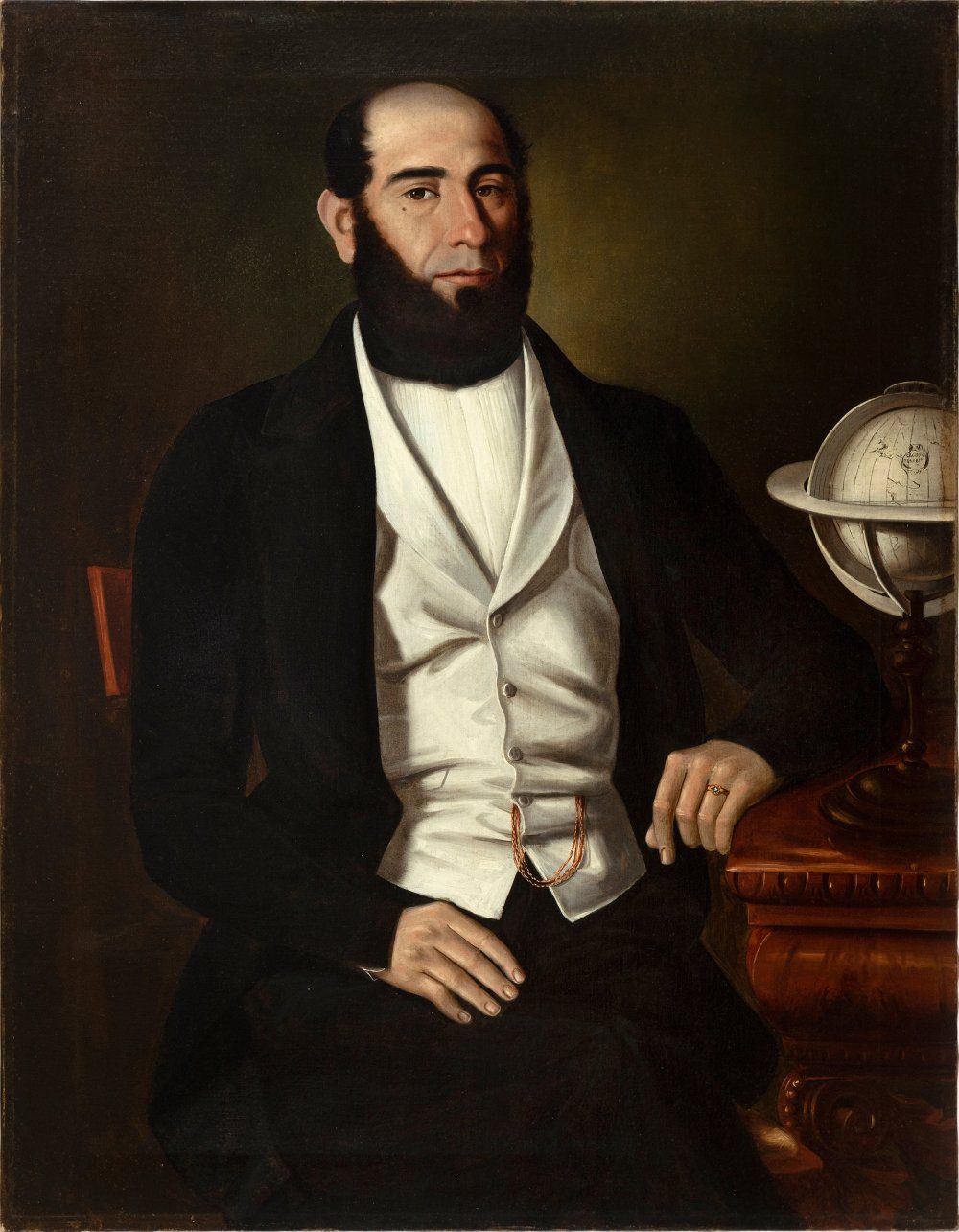Description
Spanish school of ca. 1840-1850. "Gentleman. Oil on canvas. With frame of Empire period. Measurements: 91 x 71 cm; 104 x 83,5 cm (frame). In this work we see a typical nineteenth-century portrait, with the gentleman of three quarters in the foreground next to a table of rich mouldings, on which a globe is presented. The gentleman is dressed in a black suit and white shirt with a high collar, and appears to be looking directly at the viewer, although his proud attitude establishes a certain distance from us. He is notable for his carefully trimmed, bushy beard. His upright position indicates the pride the sitter feels in his profession (possibly a cartographer or geographer); the rich clothing and ostentatious interior allude to the high social position he enjoyed, certainly among the most exclusive circles of eighteenth-century Spanish society. The portrait is set against a neutral, dark background from which the figure emerges illusionistically, illuminated directly by a homogeneous light that leaves behind the excessive, chiaroscuro contrasts of light and shade of the previous century. In the 18th century, European portraiture was varied and wide-ranging, with numerous influences and largely determined by the tastes of both the clientele and the painter himself. However, this century saw the birth of a new concept of portraiture that would evolve throughout the century and unify all the national schools: the desire to capture the personality and character of the human being, beyond his external reality and social rank, in his effigy. During the previous century, portraiture had become established among the upper classes and was no longer reserved solely for the court. For this reason, as the 17th and even more so in the 18th century, the formulas of the genre became more relaxed and moved away from the ostentatious and symbolic official representations typical of the Baroque apparatus. On the other hand, the 18th century reacted against the rigid etiquette of the previous century with a more human and individual conception of life, and this was reflected in all areas, from furniture, which became smaller and more comfortable, replacing the large gilded and carved pieces of furniture, to the portrait itself, which came to dispense, as we see here, with all symbolic or scenographic elements in order to depict the individual rather than the personage.
41
Spanish school of ca. 1840-1850. "Gentleman. Oil on canvas. With frame of Empire period. Measurements: 91 x 71 cm; 104 x 83,5 cm (frame). In this work we see a typical nineteenth-century portrait, with the gentleman of three quarters in the foreground next to a table of rich mouldings, on which a globe is presented. The gentleman is dressed in a black suit and white shirt with a high collar, and appears to be looking directly at the viewer, although his proud attitude establishes a certain distance from us. He is notable for his carefully trimmed, bushy beard. His upright position indicates the pride the sitter feels in his profession (possibly a cartographer or geographer); the rich clothing and ostentatious interior allude to the high social position he enjoyed, certainly among the most exclusive circles of eighteenth-century Spanish society. The portrait is set against a neutral, dark background from which the figure emerges illusionistically, illuminated directly by a homogeneous light that leaves behind the excessive, chiaroscuro contrasts of light and shade of the previous century. In the 18th century, European portraiture was varied and wide-ranging, with numerous influences and largely determined by the tastes of both the clientele and the painter himself. However, this century saw the birth of a new concept of portraiture that would evolve throughout the century and unify all the national schools: the desire to capture the personality and character of the human being, beyond his external reality and social rank, in his effigy. During the previous century, portraiture had become established among the upper classes and was no longer reserved solely for the court. For this reason, as the 17th and even more so in the 18th century, the formulas of the genre became more relaxed and moved away from the ostentatious and symbolic official representations typical of the Baroque apparatus. On the other hand, the 18th century reacted against the rigid etiquette of the previous century with a more human and individual conception of life, and this was reflected in all areas, from furniture, which became smaller and more comfortable, replacing the large gilded and carved pieces of furniture, to the portrait itself, which came to dispense, as we see here, with all symbolic or scenographic elements in order to depict the individual rather than the personage.
